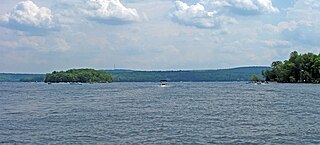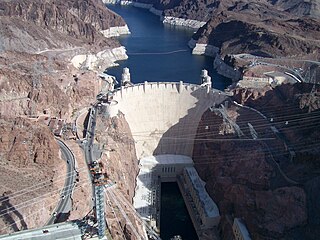
Hydroelectricity, or hydroelectric power, is electricity produced from hydropower. In 2020 hydropower generated one sixth of the world's electricity, almost 4500 TWh, which was more than all other renewables combined and also more than nuclear power.

The Conowingo Dam is a large hydroelectric dam in the lower Susquehanna River near the town of Conowingo, Maryland. The medium-height, masonry gravity dam is one of the largest non-federal hydroelectric dams in the U.S., and the largest dam in the state of Maryland.

Lake Wallenpaupack is a reservoir in northeastern Pennsylvania. After Raystown Lake, it is the second-largest lake contained entirely in Pennsylvania. It comprises 52 miles of shoreline, with a length of 13 miles and a maximum depth of 60 feet, and has a surface area in excess of 5,700 acres. It was created in 1926 by the Pennsylvania Power & Light Company (PP&L) for hydroelectric purposes as well as flood control; however, it is best known as one of several major recreational destinations in the Pocono Mountains. It is located near the Borough of Hawley, and forms part of the boundary between Pike and Wayne counties. See map.

The Susquehanna Steam Electric Station, a nuclear power station, is on the Susquehanna River in Salem Township, Luzerne County, Pennsylvania.

The Robert Moses Niagara Hydroelectric Power Station is a hydroelectric power station in Lewiston, New York, near Niagara Falls. Owned and operated by the New York Power Authority (NYPA), the plant diverts water from the Niagara River above Niagara Falls and returns the water into the lower portion of the river near Lake Ontario. It uses 13 generators at an installed capacity of 2,525 MW (3,386,000 hp).

The Safe Harbor Dam is a concrete gravity dam, with an associated hydroelectric power station, on the lower Susquehanna River. It is the most northerly and last of three Great Depression-era public electrification projects' hydroelectric dams, and was constructed between 1 April 1930 and 7 December 1931. It created a long and relatively shallow lake, known as Lake Clarke, along the upper stretch of the Conejohela Valley. The creation of the lake shrank the upper Conejohela Flats in size.
Muddy Run Pumped Storage Facility was built by the Philadelphia Electric Company and is a pumped-storage hydroelectric generation facility in Drumore Township, Pennsylvania, United States. When completed in 1968, Muddy Run was the largest pumped-storage facility in the world. The facility is operated by the Susquehanna Electric Company, a subsidiary of Constellation Energy. Ernest Spey was the superintendent of Conowingo Hydroelectric Dam and the new Muddy Run facility until 1989.
York Haven Dam is a low head, run-of-the river, dam and hydroelectric plant on the Susquehanna River, United States. The dam is 12 miles (19 km) south of Harrisburg, Pennsylvania, at the Conewago Falls impounding about 8,000 feet (2,400 m) of the river to the west side of Three Mile Island, where the river drops 19 feet (5.8 m) in 1⁄4 mile (0.40 km). When the dam was completed in 1904, it was the third largest in the world.
Tenom Pangi Dam is the hydroelectric plant in Tenom, Sabah, Malaysia. It is located 120 km (75 mi) south of Kota Kinabalu on the Padas River. The project is a run-of-river hydroelectric power plant. Tenom Pangi Dam is the only major hydroelectric dam in Sabah.

The Caruachi Dam is a concrete gravity dam on the Caroní River in Bolivar state, Venezuela. It supports a hydroelectric power facility with a 2,160 megawatts (2,900,000 hp) capacity. It is about 59 kilometres (37 mi) downstream from the Guri Dam belonging to the Central Hidroeléctrica Simón Bolívar, and about 35 kilometres (22 mi) from where the Caroni and Orinoco rivers meet at Ciudad Guayana.
The Deep Creek Dam located about 8 miles north of Oakland, Maryland, consists of an earth and rockwall dam across a tributary of the Youghiogheny River that was completed in 1925 by the Pennsylvania Electric Company. Construction of the dam created the Deep Creek Lake. The twin water turbine 20 MW hydroelectric plant, acquired by Brookfield Renewable Power, Inc., in 2005, became operational in 1928. The Federal Energy Regulatory Commission licensed the dam and hydroelectric plant in 1968, but released the licensing to Maryland effective 1994. Under a 1994 agreement with the Maryland Department of Natural Resources, the dam is operated to control waterflows to maintain the river temperature and dissolved oxygen levels to assist downstream fisheries with the intent of increasing the number of trout as well as to enable recreational whitewater activities on the Upper Youghiogheny River into which the dam releases. The Maryland Department of the Environment water appropriations permit under which the dam operates, which is renewable, will expire on January 1, 2018.
The Bell Bend Nuclear Power Plant was a proposed nuclear power plant, which would have been built on the Bell Bend of the Susquehanna River in Luzerne County, Pennsylvania adjacent to the Susquehanna Steam Electric Station.

Brunner Island Steam Electric Station is a coal-fired electrical generation facility in York County, Pennsylvania. It occupies most of the area of the eponymous island on Susquehanna River. The power plant has three major units, which came online in 1961, 1965, and 1969, with respective generating capacities of 334 MW, 390 MW, and 759 MW. In addition, three internal combustion generators were installed in 1967. Talen Energy will stop coal use at the plant in 2028.

Hydroelectric power in the United States is, as of 2019, the second-largest renewable source of energy in both generation and nominal capacity. In 2021, hydroelectric power produced 31.5% of the total renewable electricity, and 6.3% of the total U.S. electricity.

Hauser Dam is a hydroelectric straight gravity dam on the Missouri River about 14 miles (23 km) northeast of Helena, Montana, in the United States. The original dam, built between 1905 and 1907, failed in 1908 and caused severe flooding and damage downstream. A second dam was built on the site in 1908 and opened in 1911 and comprises the present structure. The current Hauser Dam is 700 feet (210 m) long and 80 feet (24 m) high. The reservoir formed by the dam, Hauser Lake, is 25 miles (40 km) long, has a surface area of 3,800 acres (1,500 ha), and has a storage capacity of 98,000 acre-feet (121,000,000 m3) of water when full.

Stave Falls Dam is a dual-dam power complex on the Stave River in Stave Falls, British Columbia, Canada. The dam was completed in 1912 for the primary purpose of hydroelectric power production. To increase the capacity of Stave Lake, the dam was raised in 1925 and the Blind Slough Dam constructed in an adjacent watercourse 500 m (1,600 ft) to the north, which was the site of the eponymous Stave Falls. In 2000, the dam's powerhouse was replaced after a four-year upgrade. The powerhouse was once British Columbia's largest hydroelectric power source and is a National Historic Site of Canada.

The Ellsworth Power House and Dam is a hydroelectric power generation facility on the Union River in Ellsworth, Maine. The dam, located just north of downtown Ellsworth, is also known as the Union River Dam, and impounds the river to create Leonard Lake, named for project's engineer, James Leonard. The powerhouse is a Renaissance Revival building located at the western end of the dam. The power plant, built in 1907, was one of the first peaking power plants built in the state, and the hollow concrete dam is one of the highest hollow buttress dams ever built, having been described as "the highest power dam in New England" in 1928. The facility was nominated for the National Register of Historic Places in 1985, where it is currently listed.
Talen Energy is an independent power producer founded in 2015. It was formed when the competitive power generation business of PPL Corporation was spun off and immediately combined with competitive generation businesses owned by private equity firm Riverstone Holdings. Following these transactions, PPL shareholders owned 65% of Talen's common stock and affiliates of Riverstone owned 35%. As a condition for FERC approval Talen agreed to divest approximately 1,300 megawatts of generating assets in the PJM Interconnection Region to mitigate FERC's competitiveness concerns. On December 6, 2016, Riverstone Holdings completed the purchase of the remaining 65% of Talen's common stock, making it a privately owned company.
The Brookfield Renewables Milford Dam, also known as the Milford Dam of Versant Power, is a hydroelectric power generation facility on the Penobscot River in Milford, Maine. Its main building, a handsome Romanesque structure, stands at the eastern end of the Milford Dam. Built in 1906, it was at that time the largest hydroelectric facility in the state, and its construction marked a shift from water to electrical power of area industries. It was listed on the National Register of Historic Places in 1988.













